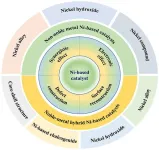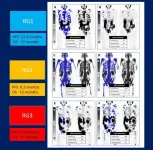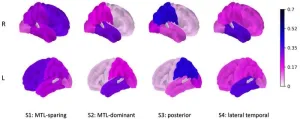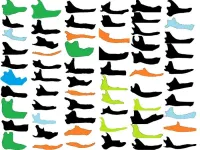(Press-News.org) Orlando, Fla., June 27, 2023 – Hand hygiene is the simplest, most effective way to prevent the spread of infections in healthcare, yet healthcare worker adherence is often low. Infection preventionists at two health systems will present their successful hand hygiene interventions at the Association for Professionals in Infection Control and Epidemiology’s (APIC’s) Annual Conference in Orlando Florida, June 26-28.
University of Michigan Health sustains 95% hospital-wide hand hygiene compliance through creation of interactive dashboards that visually depict data
In August of 2018, University of Michigan Health, based in Ann Arbor, Michigan, transitioned from using static charts to creating dynamic electronic dashboards to visualize hand hygiene compliance in real time across its 1,100-bed campus. Through use of commercially available Business Intelligence (BI) software, they generated weekly and monthly compliance reports, made month-to-month comparisons, and filtered data by unit and by role (e.g., Environmental Services, Nursing, etc.) to show the rate at which healthcare workers cleaned their hands at the appropriate moments. Details about specific missed opportunities, like a failure to perform hand hygiene prior to donning personal protective equipment, were included.
A month after the infection prevention team implemented the dashboards, 19 units improved to 95% compliance or greater from rates that were already in the high 80s. From November 2018 to February 2020 at the beginning of the pandemic, the hospital overall sustained a 95% or greater rate of adherence. Rates fell to 86% in March 2021 because the program was paused during the pandemic but have risen to 98% as of April 2023 through reintroduction and use of the dashboards and real-time data sharing.
University of Michigan Health relies on a robust team of trained observers to covertly monitor hand hygiene compliance, rather than an electronic system. ‘Secret shoppers’ track observations in the software using a mobile phone and that data is fed back to stakeholders in real time.
“We had already addressed hand hygiene at a global level at our facility and had achieved levels in the upper 80s and low 90s, but our goal was 95%,” said Harry Zhen, MPH, CIC, infection preventionist at University of Michigan Health. “The BI software allowed us to pinpoint departments and shifts that were struggling and stratify data by role types so we could have more meaningful conversations to drive improvement.”
The oral abstract, “Data Rather Than Germs on Your Fingertips: Leveraging Business Intelligence to Improve and Sustain Hand Hygiene Compliance,” is being presented at 2:51 pm ET, June 27 at the APIC Annual Conference in Orlando, Fla.
Automated Hand Hygiene Monitoring Helps Newark Beth Israel Medical Center Achieve 98% Increase in Compliance
When they trialed an automated hand hygiene monitoring system (AHHMS) in 2019, Newark Beth Israel Medical Center recognized opportunities to use this technology to improve hand hygiene compliance at their 665-bed, regional care teaching hospital that provides comprehensive health care.
After a 21-day baseline period in February 2022, the hospital deployed the AHHMS in eight adult inpatient units covering about 200 patient rooms. The AHHMS senses every opportunity for hand hygiene and counts actual dispenses of hand sanitizer to compute the compliance rate.
The intervention took place over a period of 56 weeks, from March 2022 – April 2023. As part of the intervention, the infection prevention team enlisted hand hygiene champions and unit managers who shared real-time data about their units during daily safety huddles with hospital leadership and during shift transitions.
During the intervention period, the median hand hygiene rate rose significantly in all units, ranging from a 67% to 132% improvement compared to baseline. The average percent increase over baseline across all eight areas was 98%.
“The automated monitoring system provides a level of accountability that is needed to supplement existing efforts and bring about a noticeable improvement in hand hygiene,” said Ndubuisi Eke-Okoro, MSc, CIC, Newark Beth Israel Medical Center infection preventionist who helped implement the intervention. “Hospital leaders at every level are actively engaged and supportive of this effort which has been critical to our success.”
The poster, “Hand Hygiene Performance Improvement Results in Adult Acute Care Units After 56-Weeks of a Novel Intervention Program,” is being presented at 11:15 am ET, June 27, at the APIC Annual Conference in Orlando, Fla.
“Hand hygiene is the cornerstone of infection prevention, but achieving and sustaining high compliance is often elusive,” said APIC 2023 President Patricia Jackson, RN, MA, CIC, FAPIC. “We congratulate the University of Michigan Health and Newark Beth Israel for implementation of such effective programs and thank them for sharing their successful approaches at APIC’s Annual Conference.”
About APIC
Founded in 1972, the Association for Professionals in Infection Control and Epidemiology (APIC) is the leading association for infection preventionists and epidemiologists. With more than 15,000 members, APIC advances the science and practice of infection prevention and control. APIC carries out its mission through research, advocacy, and patient safety; education, credentialing, and certification; and fostering development of the infection prevention and control workforce of the future. Together with our members and partners, we are working toward a safer world through the prevention of infection. Join us and learn more at apic.org.
APIC’s Annual Conference, June 26-28, is one of the most comprehensive infection prevention conferences in the world, with programs led by experts from across the globe and attended by physicians, researchers, epidemiologists, educators, administrators, and medical technologists, with strategies that can be implemented immediately to improve prevention programs and make healthcare safer. Join the conversation on social media with the hashtag #APIC2023.
# # #
END
ARLINGTON, Va. (June 27, 2023) — A group of five medical organizations have released updated recommendations for the prevention of methicillin-resistant Staphylococcus aureus, known as MRSA, transmission and infection. MRSA causes approximately 10% of hospital-associated infections in the United States and such infections are associated with an increased risk of death. Certain infections caused by MRSA rose by as much as 41% during the pandemic after falling in preceding years.
Strategies to Prevent Methicillin-Resistant Staphylococcus aureus Transmission and Infection in Acute Care Hospitals provides evidence-based, ...
Computer scientists at the University of Waterloo have discovered a method of attack that can successfully bypass voice authentication security systems with up to a 99% success rate after only six tries.
Voice authentication – which allows companies to verify the identity of their clients via a supposedly unique “voiceprint” – has increasingly been used in remote banking, call centers and other security-critical scenarios.
“When enrolling in voice authentication, ...
Prof. Okujima, in collaboration with Prof. Kobayashi at Shinshu University, reported the synthesis, molecular structure, optical properties and electronic structure of unusual phenanthrene-fused porphyrins.
Precursor porphyrins fused with aryl-substituted bicyclo[2.2.2]octadiene afforded the corresponding arylbenzoporphyrins (arylBPs) by retro Diels–Alder reaction. Unusual phenanthroporphyrins were obtained via the intramolecular Scholl reaction of arylBPs. We analyzed the optical and electronic structures using magnetic circular dichroism spectroscopy and time-dependent density functional theory calculations.
Our ...
The study is led by Ligang Feng (School of Chemistry and Chemical Engineering, Yangzhou University).
The rapid development of the economy driven by the large consummation of traditional fossil fuels is not sustainable, and global attention is shifted to the utilization of renewable energy sources, and biomass fuels. Methanol is considered a good biomass fuel to realize energy storage and conversion, which is convenient for storage and transportation; more importantly, it is much safer than other fuels such as gasoline, diesel, and natural gas. In addition, it can be prepared with wide sources in low-cost and ...
Diamond has long been the go-to material for quantum sensing due to its coherent nitrogen-vacancy centres, controllable spin, sensitivity to magnetic fields, and ability to be used at room temperature. With such a suitable material so easy to fabricate and scale, there’s been little interest in exploring diamond alternatives. But this GOAT of the quantum world has one Achilles Heel… It’s too big. Just as an NFL linebacker is not the best sportsperson to ride in the Kentucky Derby, diamond is not an ideal material when exploring quantum sensors and information processing. ...
Chicago, Illinois (Embargoed until 3:45 p.m. CDT, Tuesday, June 27, 2023)—By monitoring early-response biomarkers in men undergoing 177Lu-PSMA prostate cancer treatment, physicians can personalize dosing intervals, significantly improving patient outcomes. In a study presented at the Society of Nuclear Medicine and Molecular Imaging 2023 Annual Meeting, early stratification with 177Lu-SPECT/CT allowed men responding to treatment to take a “treatment holiday” and allowed those not responding the option to switch to another treatment.
Approved by the U.S. Food ...
Chicago, Illinois (Embargoed until 4:05 p.m. CDT, Tuesday, June 27, 2023)—A new computational technique that combines genomic and tau PET imaging data promises a more personalized approach for subtyping Alzheimer’s disease. Based on a novel clustering framework using sparse canonical correlation analysis (SCCA), the integrated approach was successful in identifying four subtypes of Alzheimer’s disease and the top genes associated with each. This research was presented at the 2023 Society of Nuclear Medicine and Molecular Imaging Annual ...
From the 20-foot-long jawbones of the filter-feeding blue whale to the short, but bone-crushing, jaws of the hyena and the delicate chin bones of a human, the pair of lower jawbones characteristic of mammals have evolved with amazing variation.
But at first glance, having a single bone on each side of the head — which creates a stiff lower jaw, or mandible — doesn't appear to give mammals an advantage over other vertebrates, which have at least two and as many as 11 bones comprising each side of the lower jaw.
Crocodiles, for example, have an edge over hyenas when it comes to their bite strength relative to ...
MIAMI, FLORIDA (June 27, 2023) – Cancer patients with unmet supportive care needs are more likely to experience worse clinical outcomes, including more emergency department (ED) visits and hospitalizations, according to new research from Sylvester Comprehensive Cancer Center at the University of Miami Miller School of Medicine.
The study, published June 21 in JAMA Network Open, also found that Black race, Hispanic ethnicity and factors such as anxiety, depression, pain, poor physical function and low health-related quality-of-life ...
CHAPEL HILL, N.C. – Diabetes is a progressive disease that affects one’s ability to control blood sugar levels. For many patients, the condition becomes more severe over time and blood sugar levels grow more difficult to manage. Glucagon-like peptide-1 (GLP-1) receptor agonists, such as semaglutide, have granted patients more control in lowering of blood sugar.
John Buse, MD, PhD, the Verne S. Caviness Distinguished Professor of Medicine in the Division of Endocrinology and Metabolism, and an international team of researchers have presented new findings about new higher-dose formulations ...







